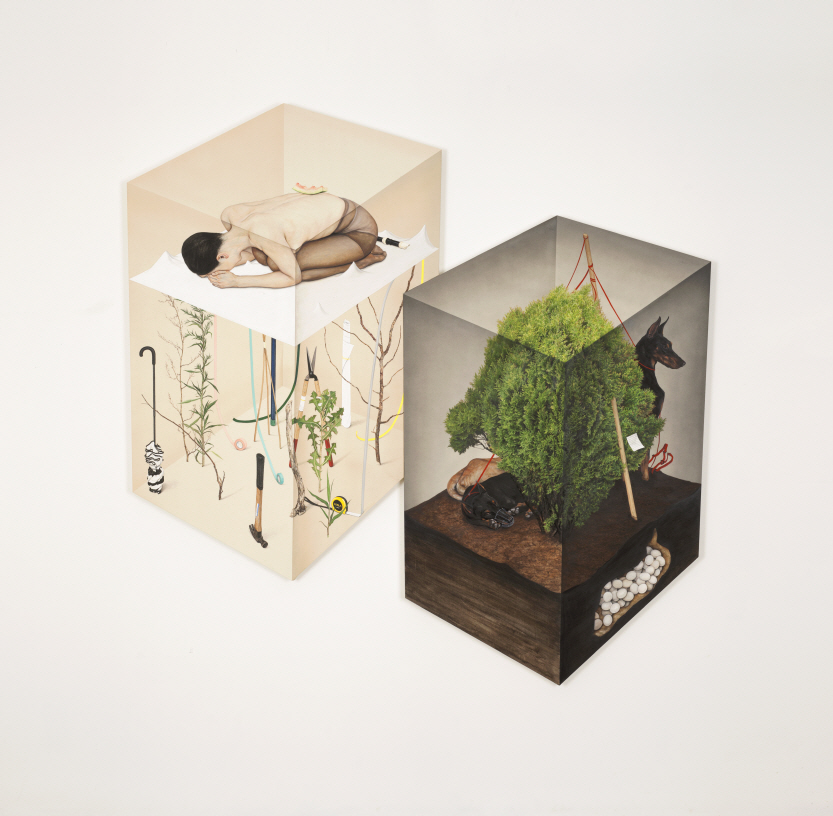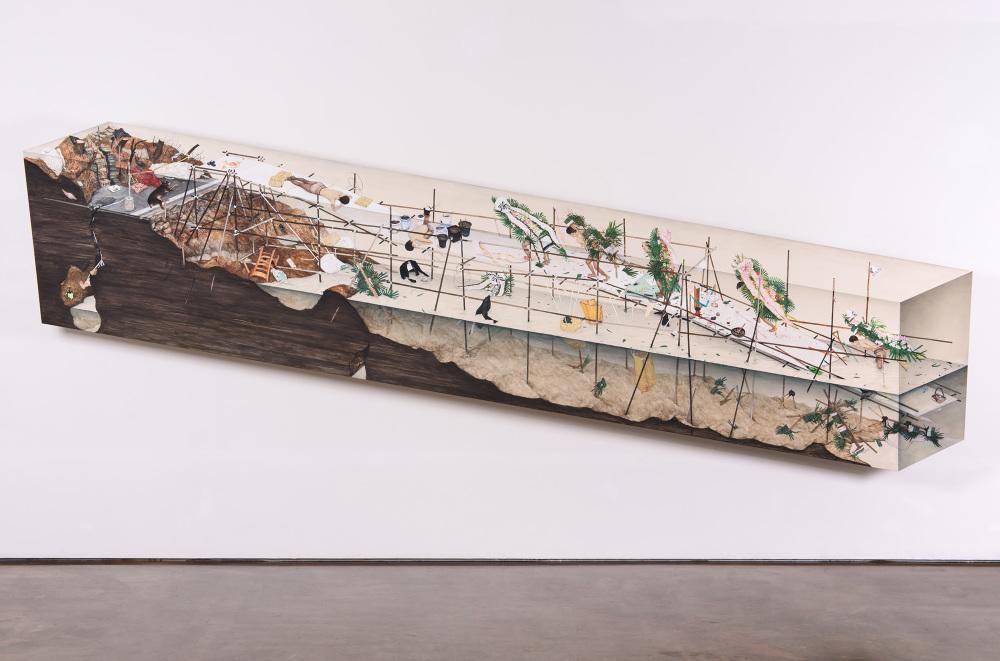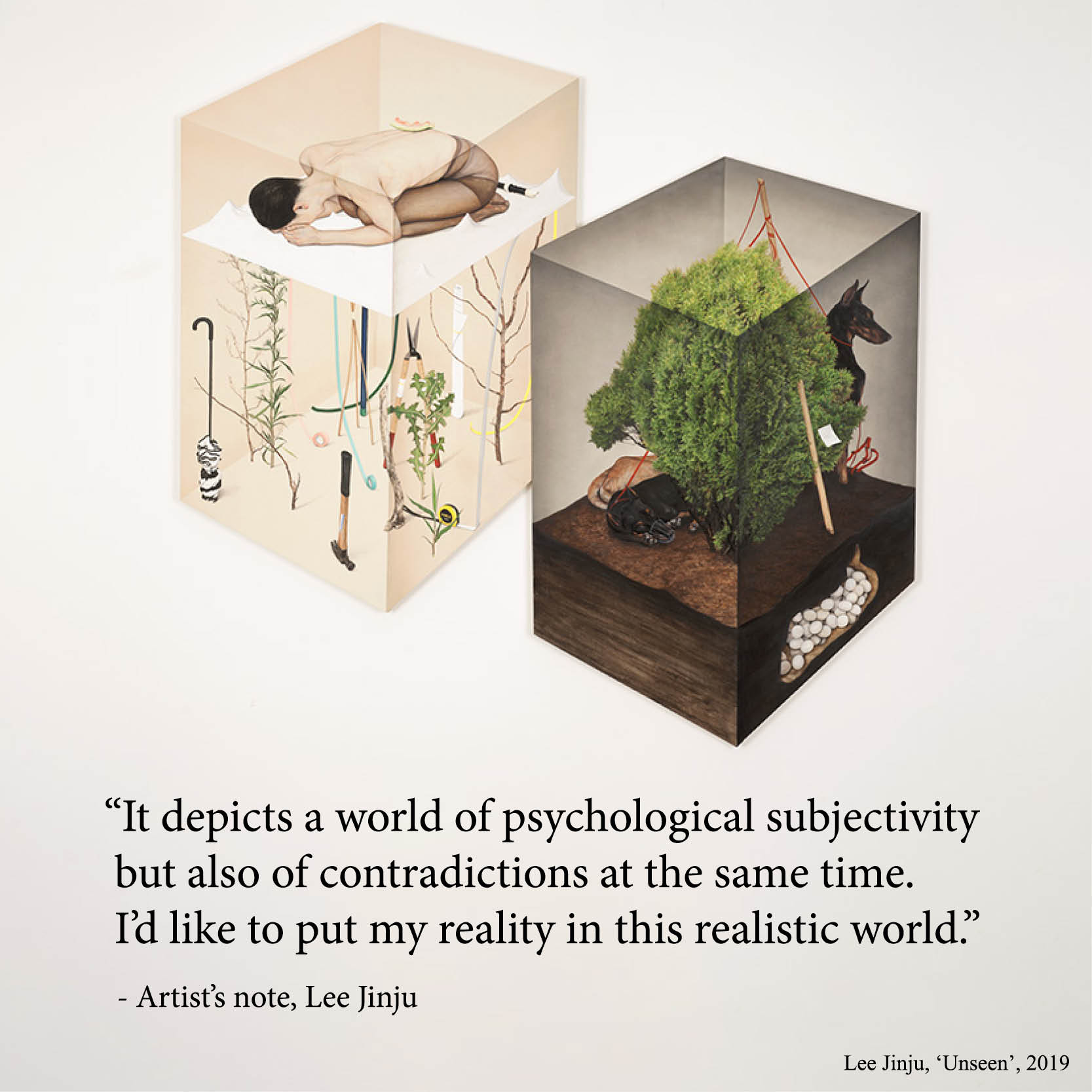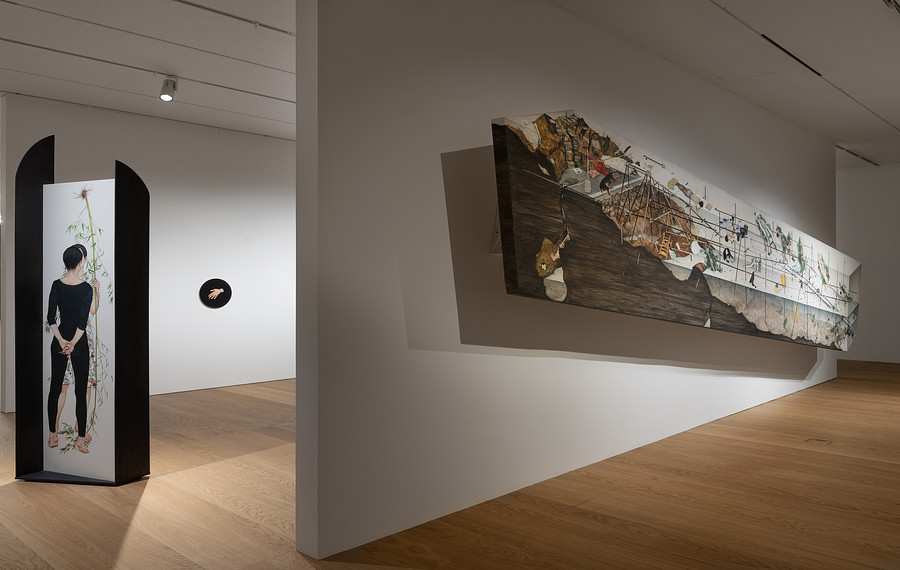
Lee Jinju, 'Unseen', 2019, Korean paint on linen, 215.5 x 213 x 6.5(d) cm
Occasionally, in our dreams, we encounter everyday occurrences, such as newly built buildings on the way home, a dog we ran into while out for a walk, and flowerpots in the front yards of our neighborhood. The scenes are so plain and routine that you might not realize you are in a dream. However, upon awakening, you finally realize that the scenes in your dream were somewhat absurd.
The artworks of Lee Jinju (b. 1980) remind us of these dreams. Using Korean painting techniques, the artist depicts each object and person in an incredibly realistic manner. The scene, however, is unreal and otherworldly because it is spread across a void space where shadows do not appear to exist.
In Lee’s paintings, garden plants, garden hoses used for watering, pigeons, crumpled pieces of paper, gardening tools, white walls, and human figures in different poses are gathered together. The unlikely association of these objects arouses curiosity about the story they may tell.

Lee Jinju, 'The Lowland (저지대),' 2017, Korean paint on linen, 222 x 550 cm.
Lee expresses her thoughts, feelings, and senses in an unfamiliar landscape composed of everyday objects and scenes. Lee often depicts scenes from her memories, such as her childhood home, but she also gives shape to her thoughts and ideas, including past traumas, affection for family, thoughts about death, questions about how memories work, and cognitive systems, such as knowledge and beliefs.
Unlike reality, memories and thoughts do not flow in chronological order. Memory fragments can be lost and shattered, their time can flow backward, and several memories can be intertwined and distorted into new stories. Thus, Lee’s landscapes are bizarre and surreal because the artist weaves these fragmented, dispersed memories into new scenery.

Lee Jinju, 'hand,wall (손, 벽),' 2017, Korean paint on linen, 53x41cm.
Just as if the artist takes a few thoughts from an infinite unconscious space where endless memories and thoughts are veiled, Lee gives shape to the various afterimages that appear in the artist’s mind and creates a new stage for them on the screen.
In some of her paintings, Lee leaves the background empty but Black Painting series, Lee turns off all the colors of other objects and the background, leaving only the face and hands illuminated to emphasize the self. In this group of artworks, Lee made her own pigment to express a highly pure matte black color.

Lee Jinju, 'The Unperceived(死角, 사각),' 2020, Korean color and acrylic on linen, 122x488cm, 122x 488cm, 122x244cm, 122x220cm
The artist’s psychological landscape is composed of a multi-layered and complex structure as if each image existed in its own unique world. Thus, Lee attempts to realize different spaces and structures in her paintings. Some images are expressed as if they are contained within a transparent cube, or they depict various landscapes within a work that are aligned in parallel. Lee also hangs her lengthy paintings on a structure so they can be viewed from a variety of perspectives.
Each unique painting contains different images and worlds; therefore, Lee frames plywood with the size and proportions that best fit the artist’s mental imagery. Lee follows the philosophy of traditional Korean painting that depicts the artist’s spirit through form but does not insist on using only the medium and technique of Korean painting. Lee uses both traditional and innovative materials in her work.
Lee’s works that evoke an image of the artist’s inner self depict our unstable existence hidden behind rationality and the norms of reality.

Artist Lee Jinju. Courtesy of the artist.
In Seoul, Arario Gallery represents the work of artist Lee Jinju. She has had solo exhibitions at Gallery Hyundai (2011, Seoul), Doosan Gallery (2014, New York), Baik Art Gallery (2017, LA), Edwins Gallery (2018, Jakarta), and Arario Museum in Space (2020, Seoul). She also participated in group exhibitions at institutions such as the National Museum of Modern and Contemporary Art (Seoul), the Korean Cultural Center in Belgium (Brussels), the Seoul Museum of Art (Seoul), the Whanki Museum of Art (Seoul), and the Ilmin Museum of Art (Seoul).
She won the 3rd Gwangju Hwaru Competition (Gwangju Bank, Korea), the Excellence Award of the 14th SongEun Art Awards (SongEun Cultural Foundation, Seoul), and the Excellence Award of the 31st Joongang Art Exhibition (Joongang Ilbo, Seoul). Lee’s works are included in the collections of the National Museum of Modern and Contemporary Art (Gwacheon, Korea), Seoul Museum of Art (Seoul), Gyeonggi Cultural Foundation (Suwon), POSCO Art Museum (Seoul), Gyeongnam Museum of Art (Changwon, Korea), OCI Museum of Art (Seoul), and the Nesrin Esirtgen Collection (Istanbul, Turkey).




















